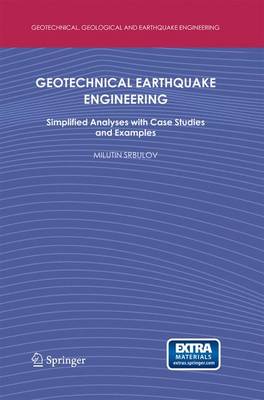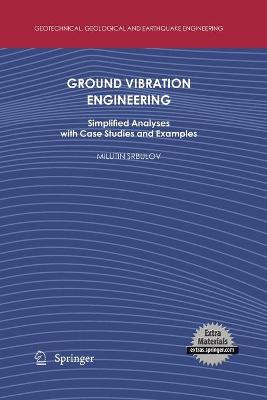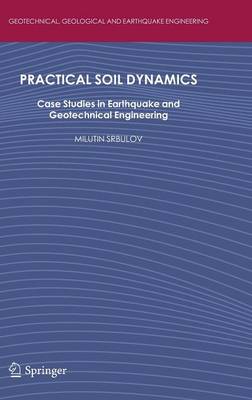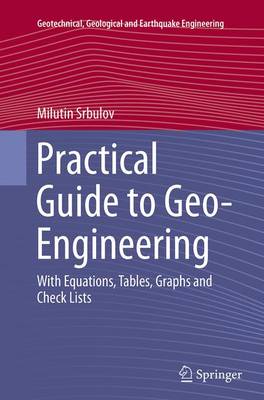Geotechnical, Geological and Earthquake Engineering
4 primary works
Book 9
... "Included on the Choice list with the outstanding academic Earth Sciences titles 2008" ...
This volume describes simplified dynamic analyses that bridge the gap between the rather limited provisions of design codes and the rather eclectic methods used in sophisticated analyses. Graphs and spreadsheets are included for the ease and speed of use of simplified analyses of:
- soil slope (in)stability and displacements caused by earthquakes,
- sand liquefaction and flow caused by earthquakes,
- dynamic soil-foundation interaction,
- bearing capacity and additional settlement of shallow foundations,
- earthquake motion effects on tunnels and shafts,
- frequent liquefaction potential mitigation measures.
A number of comments on the assumptions used in different methods, limitation and factors affecting the results are given. Several case histories are also included in the appendices in order to assess the accuracy and usefulness of the simplified methods.
Audience
This work is of interest to geotechnical engineers, engineering geologists, earthquake engineers and students.
Book 12
Ground vibration consideration is gaining significance with people’s decreasing tolerance of vibration, introduction of new environmental legislations, increasing use of equipment sensitive to vibration, ageing of existing buildings and expanding construction sites to/near collapsible/liquefiable/thixotropic soil.
This volume bridges the gap that exists between rather limited provisions of engineering codes/standards and complex numerical analyses/small-scale tests.
The book contains descriptions of ground vibration measurements, predictions and control for engineers. Effects of most frequent sources of ground vibration arising from construction/demolition, traffic and machinery, ground wave amplification and attenuation as well as foundation kinematic and inertial interaction have been considered by simplified analyses aimed at ease and speed of use for major problems in ground vibration engineering. Comments on assumptions, limitations, and factors affecting the results are given. Case studies and examples worldwide are included to illustrate the accuracy and usefulness of simplified methods. A list of references is provided for further consideration, if desired.
Audience: This work is of interest to geotechnical engineers, engineering geologists, earthquake engineers and students.
Extra material: Microsoft Excel spreadsheets with the input data and results for the case studies and examples considered in this book are available at http://extras.springer.com
Book 20
The objective of this book is to fill some of the gaps in the existing engineering codes and standards related to soil dynamics, concerning issues in earthquake engineering and ground vibrations, by using formulas and hand calculators. The usefulness and accuracy of the simple analyses are demonstrated by their implementation to the case histories available in the literature. Ideally, the users of the volume will be able to comment on the analyses as well as provide more case histories of simple considerations by publishing their results in a number of international journals and conferences. The ultimate aim is to extend the existing codes and standards by adding new widely accepted analyses in engineering practice.
The following topics have been considered in this volume:
• main ground motion sources and properties
• typical ground motions, recording, ground investigations and testing
• soil properties used in simple analyses
• fast sliding in non-liquefied soil
• flow of liquefied sandy soil
• massive retaining walls
• slender retaining walls
• shallow foundations
• piled foundations
• tunnels, vertical shafts and pipelines
• ground vibration caused by industry.
Audience:
This book is of interest to geotechnical engineers, engineering geologists, earthquake engineers and students
Book 29
This handy reference manual puts a wealth of ready-to-use information, data, and practical procedures within immediate reach of geo-engineers and technicians, whether they be in the field or office. It assembles and organizes the most-needed set of equations, tables, graphs and check-lists on six major subfields of geo-engineering: investigations, testing, properties, hazards, structures and works.
This practical reference for the professional and others interested in the subject of ground engineering skips lengthy definitions to highlight best practice and methods proven most effective. While reflecting codes and standards, it also fills the gaps with non-standard approaches when existing ones are skimpy on practical details or agreement. Enhanced by 146 illustrations and 83 tables, the Practical Guide to Geo-Engineering points users to supporting information and data through its extensive reference list.
Audience:
This book is of interest to everyone involved in practical geo-engineering.



